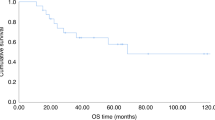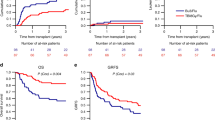Summary:
We prospectively evaluated mixed chimerism (MC) in the T cell and myeloid lineages and its correlation to busulphan, single-dose total body irradiation (TBI) and fractionated TBI (fTBI) conditioning in 180 patients with haematological malignancies after allogeneic stem cell transplantation (SCT). In all patients receiving busulphan, the area under curve (AUC) was calculated. The incidence of MC in the T cell lineage was significantly lower in patients receiving fTBI (22%) compared to those given TBI (53%, P=0.02) or busulphan (47%, P<0.01). The incidence of myeloid MC did not differ between the three groups. The overall probability of acute graft-versus-host disease grades II–IV was significantly higher in patients with complete T cell donor chimerism (49%) compared to patients with T cell MC (23%, P<0.001). The incidence of T cell and myeloid MC after SCT did not differ between low (55%), medium (42%) and high (43%) AUC levels of busulphan during conditioning. Patients receiving fTBI had a significantly higher probability of relapse compared to busulphan-treated patients (44 vs l6%, P=0.01). In multivariate analysis adjusted for diagnosis, busulphan-treated patients showed both a better survival (P=0.04) and less probability of relapse (0.03) compared to TBI-treated patients.
This is a preview of subscription content, access via your institution
Access options
Subscribe to this journal
Receive 12 print issues and online access
$259.00 per year
only $21.58 per issue
Buy this article
- Purchase on Springer Link
- Instant access to full article PDF
Prices may be subject to local taxes which are calculated during checkout



Similar content being viewed by others
References
Ringden O . Allogeneic bone marrow transplantation for hematological malignacies –controversies and recent advances. Acta Oncol 1997; 36: 549–564.
Cosset JM, Socie G, Dubray B et al. Single dose versus fractionated total body irradiation before bone marrow transplantation: radiobiological and clinical considerations. Int J Radiat Oncol Biol Phys 1994; 30: 477–492.
Hassan M . The role of busulfan in bone marrow transplantation. Med Oncol 1999; 16: 166–176.
Sanders JE . The impact of marrow transplant preparative regimens on subsequent growth and development. The Seattle Marrow Transplant Team. Semin Hematol 1991; 28: 244–249.
von Bueltzingsloewen A, Esperou-Bourdeau H, Souillet G et al. Allogeneic bone marrow transplantation following a busulfan-based conditioning regimen in young children with acute lymphoblastic leukemia: a Cooperative Study of the Societe Francaise de Greffe de Moelle. Bone Marrow Transplant 1995; 16: 521–527.
Bar BM, Schattenberg A, De Man AJ et al. Influence of the conditioning regimen on erythrocyte chimerism, graft-versus-host disease and relapse after allogeneic transplantation with lymphocyte depleted marrow. Bone Marrow Transplant 1992; 10: 45–52.
Bolinger AM, Zangwill AB, Slattery JT et al. An evaluation of engraftment, toxicity and busulfan concentration in children receiving bone marrow transplantation for leukemia or genetic disease. Bone Marrow Transplant 2000; 25: 925–930.
Fishleder AJ, Bolwell B, Lichtin AE . Incidence of mixed chimerism using busulfan/cyclophosphamide containing regimens in allogeneic bone marrow transplantation. Bone Marrow Transplant 1992; 9: 293–297.
Frassoni F, Strada P, Sessarego M et al. Mixed chimerism after allogeneic marrow transplantation for leukaemia: correlation with dose of total body irradiation and graft-versus-host disease. Bone Marrow Transplant 1990; 5: 235–240.
Chalmers EA, Sproul AM, Mills KI et al. Effect of radiation dose on the development of mixed haemopoietic chimerism following T cell-depleted allogeneic bone marrow transplantation. Bone Marrow Transplant 1992; 10: 425–430.
Mackinnon S, Barnert L, Bourhis JH et al. Myeloid and lymphoid chimerism after T-cell-depleted bone marrow transplantation: evaluation of conditioning regimens using the polymerase chain reaction to amplify human minisatellite regions of genomic DNA. Blood 1992; 80: 3235–3241.
van Leeuwen JE, van Tol MJ, Joosten AM et al. Persistence of host-type hematopoiesis after allogeneic bone marrow transplantation for leukemia is significantly related to the recipient's age and/or the conditioning regimen but it is not associated with an increased risk of relapse. Blood 1994; 83: 3059–3067.
Przepiorka D, Ramberg R, Thomas ED . Host metaphases after chemoradiotherapy and allogeneic bone marrow transplantation for acute nonlymphoblastic leukemia. Leuk Res 1989; 13: 661–665.
Demers DB, Curry ET, Egholm M et al. Enhanced PCR amplification of VNTR locus D1S80 using peptide nucleic acid (PNA). Nucleic Acids Res 1995; 23: 3050–3055.
Ringden O, Remberger M, Carlens S et al. Low incidence of acute graft-versus-host disease, using unrelated HLA-A-, HLA-B-, and HLA-DR-compatible donors and conditioning including anti-T-cell antibodies. Transplantation 1998; 66: 620–625.
Olerup O, Zetterquist H . HLA-DR typing by PCR amplification with sequence-specific primers (PCR-SSP) in 2 hours: an alternative to serological DR typing in clinical practice including donor–recipient matching in cadaveric transplantation [see comments]. Tissue Antigens 1992; 39: 225–235.
Ringden O, Remberger M, Ruutu T et al. Increased risk of chronic graft-versus-host disease, obstructive bronchiolitis, and alopecia with busulfan versus total body irradiation: long-term results of a randomized trial in allogeneic marrow recipients with leukemia. Nordic Bone Marrow Transplantation Group. Blood 1999; 93: 2196–2201.
Remberger M, Svahn BM, Hentschke P et al. Effect on cytokine release and graft-versus-host disease of different anti-T cell antibodies during conditioning for unrelated haematopoietic stem cell transplantation. Bone Marrow Transplant 1999; 24: 823–830.
Storb R, Deeg HJ, Whitehead J et al. Methotrexate and cyclosporine compared with cyclosporine alone for prophylaxis of acute graft versus host disease after marrow transplantation for leukemia. N Engl J Med 1986; 314: 729–735.
Ringden O, Remberger M, Persson U et al. Similar incidence of graft-versus-host disease using HLA-A, -B and -DR identical unrelated bone marrow donors as with HLA-identical siblings. Bone Marrow Transplant 1995; 15: 619–625.
Glucksberg H, Storb R, Fefer A et al. Clinical manifestations of graft-versus-host disease in human recipients of marrow from HL-A-matched sibling donors. Transplantation 1974; 18: 295–304.
Aschan J . Treatment of moderate to severe acute graft-versus-host disease: a retrospective analysis. Bone Marrow Transplant 1994; 14: 601–607.
Mattsson J, Uzunel M, Tammik L et al. Leukemia lineage-specific chimerism analysis is a sensitive predictor of relapse in patients with acute myeloid leukemia and myelodysplastic syndrome after allogeneic stem cell transplantation. Leukemia 2001; 15: 1976–1985.
Hassan M, Fasth A, Gerritsen B et al. Busulphan kinetics and limited sampling model in children with leukemia and inherited disorders. Bone Marrow Transplant 1996; 18: 843–850.
Kaplan E, Meier P . Nonparametric estimation from incomplete observations. J Am Stat Assoc 1958; 53: 457–481.
Kalbfleisch J, Prentice R . The Statistical Analysis of Failure Time Data. John Wiley and Sons: New York, 1980.
Socie G, Lawler M, Gluckman E et al. Studies on hemopoietic chimerism following allogeneic bone marrow transplantation in the molecular biology era. Leuk Res 1995; 19: 497–504.
Down JD, Tarbell NJ, Thames HD et al. Syngeneic and allogeneic bone marrow engraftment after total body irradiation: dependence on dose, dose rate, and fractionation. Blood 1991; 77: 661–669.
van Os R, Thames HD, Konings AW et al. Radiation dose-fractionation and dose-rate relationships for long-term repopulating hemopoietic stem cells in a murine bone marrow transplant model. Radial Res 1993; 136: 118–125.
Mattsson J, Uzunel M, Remberger M et al. T cell mixed chimerism is significantly correlated to a decreased risk of acute graft-versus-host disease after allogeneic stem cell transplantation. Transplantation 2001; 71: 433–439.
Hill GR, Crawford JM, Cooke KR et al. Total body irradiation and acute graft-versus-host disease: the role of gastrointestinal damage and inflammatory cytokines. Blood 1997; 90: 3204–3213.
Aschan J, Carlens S, Hagglund H et al. Improved survival after bone marrow transplantation for early leukemia using busulfan-cyclophosphamide and individualized prophylaxis against graft-versus-host disease: a long-term follow-up. Clin Transplant 1999; 13: 512–519.
Carlens S, Ringden O, Aschan J et al. Risk factors in bone marrow transplant recipients with leukaemia. Increased relapse risk in patients treated with ciprofloxacin for gut decontamination. Clin Transplant 1998; 12: 84–92.
Davies S, Ramsay N, Klein J et al. Comparison of preparative regimens in transplants for children with acute lymphoblastic leukemia. J Clin Oncol 2000; 18: 340–347.
van Leeuwen JE, van Tol MJ, Joosten AM et al. Mixed T-lymphoid chimerism after allogeneic bone marrow transplantation for hematologic malignancies of children is not correlated with relapse. Blood 1993; 82: 1921–1928.
Hagenbeek A, Van Bekkum DW . Comparison of different total body irradiation regimens combined with bone marrow transplantation in a rat model for human myelocytic leukemia. Int J Radial Biol 1979; 36: 412–413.
Uckun FM, Chandan-Langlie M, Jaszcz W et al. Radiation damage repair capacity of primary clonogenic blasts in acute lymphoblastic leukemia. Cancer Res 1993; 53: 1431–1436.
Acknowledgements
We are indebted to Lotta Tammik and Giti Bayat for their excellent technical assistance. We also thank the staff in the Centre for Allogeneic Stem Cell Transplantation, Huddinge University Hospital for competent and compassionate patient care. This study was supported by grants from the Swedish Cancer Foundation (0070-B96-10XAC; 4147-B99-02XBB), the Children's Cancer Foundation (1998-002; 2001-059), the Swedish Medical Research Council (K97-06X-05971-17A), the Tobias Foundation, the FRF Foundation and Ellen Bechrach Foundation, Stockholm Cancer Society 02:119.
Author information
Authors and Affiliations
Rights and permissions
About this article
Cite this article
Mattsson, J., Uzunel, M., Remberger, M. et al. Fractionated TBI correlates with less T cell mixed chimerism but increased risk of relapse compared to busulphan in patients with haematological malignancies after allogeneic stem cell transplantation. Bone Marrow Transplant 32, 477–483 (2003). https://doi.org/10.1038/sj.bmt.1704154
Received:
Accepted:
Published:
Issue Date:
DOI: https://doi.org/10.1038/sj.bmt.1704154
Keywords
This article is cited by
-
Chimerism status is correlated to acute graft-versus-host disease after allogeneic stem cell transplantation
International Journal of Hematology (2014)
-
CD34+ cell dose, conditioning regimen and prior chemotherapy: factors with significant impact on the early kinetics of donor chimerism after allogeneic hematopoietic cell transplantation
Bone Marrow Transplantation (2004)



